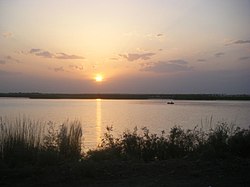Amu Darya
| Amu Darya | |
|---|---|
 | |
| Physical characteristics | |
| Mouth | None, formerly Aral Sea |
| Length | 2,400 km (1,500 mi) |

The Amu Darya (formerly Oxus River; the Greeks (Ptolemeus) called it Oxiana palus) is the longest river in Central Asia. Its name is sometimes represented in a single word, Amudarya (Tajik: Омударё or дарёи Ому - Omudaryo or daryoi Omu; Persian: آمودریا - Âmudaryâ; Uzbek: Amudaryo, with darya (Pahlavi) meaning sea or a very large river).
Amu is said to have come from the city of Āmul, now known as Türkmenabat. It is formed by the junction of the Vakhsh and Panj rivers. Many local people refer to the river as Jayhoun (جيحون) which was thought to be a derivative of Gihon, the biblical name for one of the four rivers of the Garden of Eden or paradise.[2] The river is also known by this name to most of the medieval Islamic writers.
Description
The river is navigable for over 1450 km (800 miles). Its total length is 2400 km (1500 miles) and its drainage basin totals 534.739 km² in area, providing a mean discharge of around 97.4 cubic kilometres[1] of water per year. All of the water comes from the high mountains in the south where annual precipitation can be over 1000 mm. Even before large-scale irrigation began, high summer evaporation meant that not all of this discharge reached the Aral Sea - though there is some evidence the large Pamir glaciers provided enough melt water for the Aral to overflow during the thirteenth and fourteenth centuries A.D.
In classical antiquity, the river was known as the Oxus in Greek--a clear derivative of Vakhsh—the name of the largest tributary of the Amu. It was known as Jayhun or Gihun in ancient Arabic sources. Jayhun was likely influenced by Dgihun, the traditional name given to it by the people who inhabited its surrounding region.[3]
In Vayu Purana and Matsya Purana, the Oxus is mentioned as the river Chakshu, flowing through the countries of Tusharas (Rishikas?), Lampakas, Pahlavas, Paradas and Shakas etc.

One source of the Amu Darya is the Pamir River, which emerges from Lake Zorkul/Victoria in the Pamir Mountains (ancient Mount Imeon), flowing east to Ishtragh, where it turns north and then east north-west through the Hindu Kush as the Panj, forming the border of Afghanistan and Tajikistan where it passes the Tajik-Afghan Friendship Bridge, and subsequently the border of Afghanistan and Uzbekistan for about 200 km, passing Termez and the Afghanistan-Uzbekistan Friendship Bridge. It follows the border of Afghanistan and Turkmenistan for another 100 km before it flows into Turkmenistan at Kerki. As the Amudarya, it flows across Turkmenistan south to north, passing Turkmenabat, and forms the border of Turkmenistan and Uzbekistan from Khalkabad. It is then split into many waterways that used to form the river delta joining the Aral Sea, passing Urgench, Dashoguz and other cities, but it does not reach what is left of the sea anymore and is lost in the desert.
Another claimed source of the Amu Darya is an ice cave at the end of the Waghjir Valley, located in the Wakhan Corridor, in the Pamir Mountains, on the border with Pakistan. A glacier turns into the Wakhan River and joins the Pamir River about 50 km downstream.
Use of water from the Amu Darya for irrigation has been a major contributing factor to the shrinking of the Aral Sea since the late 1950s.
Historical records state that in different periods, the river flowed into the Aral Sea (from the south), the Caspian Sea (from the east) or both, similar to the Syr Darya (Jaxartes, in Ancient Greek).
See also
References
- Curzon, George Nathaniel. 1896. The Pamirs and the Source of the Oxus. Royal Geographical Society, London. Reprint: Elibron Classics Series, Adamant Media Corporation. 2005. ISBN 1-4021-5983-8 (pbk; ISBN 1-4021-3090-2 (hbk).
- Gordon, T. E. 1876. The Roof of the World: Being the Narrative of a Journey over the high plateau of Tibet to the Russian Frontier and the Oxus sources on Pamir. Edinburgh. Edmonston and Douglas. Reprint by Ch'eng Wen Publishing Company. Taipei. 1971.
- Toynbee, Arnold J. 1961. Between Oxus and Jumna. London. Oxford University Press.
- Wood, John, 1872. A Journey to the Source of the River Oxus. With an essay on the Geography of the Valley of the Oxus by Colonel Henry Yule. London: John Murray.
Notes
- ^ a b http://www.ce.utexas.edu/prof/mckinney/papers/aral/CentralAsiaWater-McKinney.pdf
- ^ William C. Brice. 1981. Historical Atlas of Islam (Hardcover). Leiden with support and patronage from Encyclopaedia of Islam. ISBN 90-04-06116-9.
- ^ Encyclopædia Britannica Online: Amu Darya
